Specialties
Avian and ExoticsCardiology
Clinical Pathology
Dentistry and Oral Surgery
Dermatology
Emergency & Critical Care
Integrative Medicine
Internal Medicine
Medical Oncology
Neurology
Ophthalmology
Orthopedics
Radiation Oncology
Radioiodine (I-131)
Radiology
Rehabilitation & Pain Management
Surgery
Theriogenology
Urethral Stent Case Study
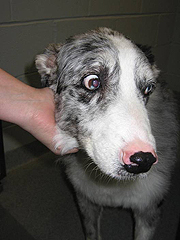
Interventional Radiology (IR) refers to a subspecialty of radiology in which advanced imaging techniques are utilized to guide the delivery of materials for diagnostic and therapeutic purposes. Veterinary IR procedures and case management are typically team efforts and are part of an initiative at NorthStar VETS directed toward providing advanced therapies for companion animals in a minimally invasive fashion. This approach to treatment facilitates shorter hospital stays, decreased pain, and a more rapid return to function. This new service will be helpful in providing patients with more options and is currently only available at our hospital.
On November 8, 2011 we performed our very first Interventional Radiology Case:
Jake is a 12 year old neutered Australian Shepherd who presented to Dr. Justin Guinan in the internal medicine service with a history of straining to urinate and bloody urine. His signs were progressive to the point where he was only dribbling urine and his bladder was very large and uncomfortable. He was unable to empty his bladder completely despite many attempts.
On ultrasound his prostate was found to be asymmetrically enlarged and mineralized (often a sign of cancer). It was suspected that Jake had a urethral obstruction secondary to prostatic neoplasia. Below is an ultrasound picture of Jake's prostate. The little white dots are mineralization in his prostate that can be a sign of cancer.
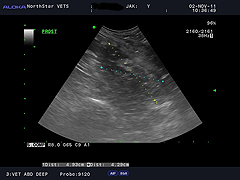
Ultimately, prostatic cancer is fatal but many dogs can enjoy a good quality of life for 6-12 months. Jake's inability to urinate made his condition immediately life threatening. In order for Jake to live, he needed a way to have his urethra opened to allow him to urinate normally. More traditional methods might have included surgery to make an opening from his bladder through his side. This procedure is invasive and has the potential for many complications.
The interventional radiology team, comprised of two surgical specialists, Drs. Garrett Levin and Ben Staiger, and an internal medicine specialist, Dr. Kimberly Hammer, placed a stent in Jake's urethra that opened up his urethra and allowed him to urinate normally. The procedure was done non-invasively (no surgical incisions) and Jake went home the next day urinating with a normal stream. Below are picture diagrams of the stent and how it fits into the urethra (Infiniti Medical LLC)
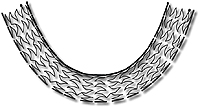
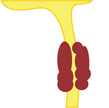
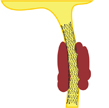
First, Jake is placed under general anesthesia. Then a procedure called a contrast cystourethrogram is performed. This involves injecting a dye into the urethra and looking at the diameter of his urethra. The dye shows up black on the fluoroscopy. Below is a video of the contrast cystourethrogram. The large black balloon like structure is his bladder. The area where the dye leaks out is around his prostate and you can see there is very little dye in this area where his urethra is obstructed.

Based on one of the frozen images from this movie, measurements are taken of the urethra to determine what size stent to place.
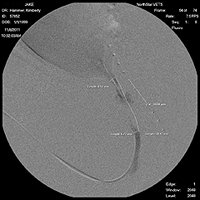
The stent is then deployed into the urethra under live fluoroscopic guidance.

We then perform another cystourethrogram to make sure the urethra is open.

Below is a radiograph of Jake's abdomen after the procedure. The stent can be seen in the back of his abdomen behind his bladder.
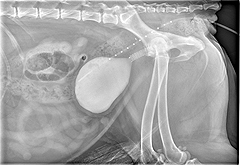
And lastly, a picture of Jake's fantastic urine stream after the procedure!
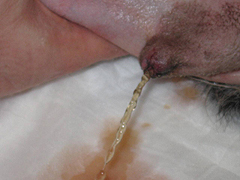
The interventional radiology and endoscopy team is now able to provide many procedures including urethral stenting, ureteral stenting, tracheal stenting, and anything else you can think of. Please contact any one of us if you have a case that you think you would benefit. If you are a pet parent and think our pet may have a condition that our team could help with, please have your veterinarian contact us to discuss your pet's condition further.













